6 Types of Dog Toilets to Save You the Annoyance
Author: Jen Worst | Editor: Omar Alonso
Review & Research: Jen Worst & Chris Miller
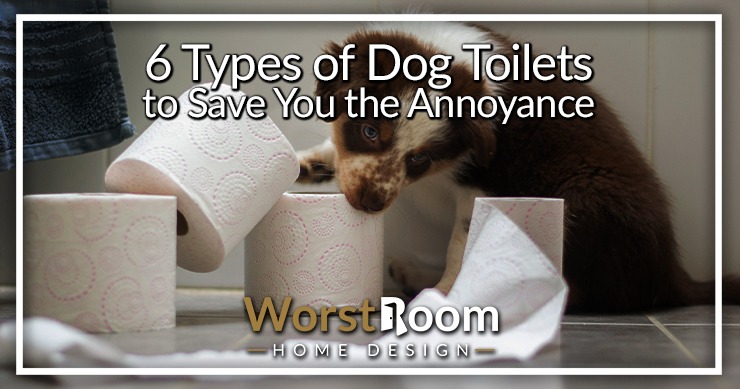
While some of us may be lucky enough to have our backyards (dog toilets!) where our pets can answer nature’s call all by themselves, the rest of us need to be available to take our dogs out every time they need to relieve themselves. Or do we?
Cue entry — indoor toilets for dogs. Yep, your furbaby can have its own restroom inside the house now. A dog toilet not only cuts you some slack on busy days but also provides your dog a familiar space to relieve itself when necessary. To further support your dog's health, incorporating the best probiotic for dogs, such as the all-natural powder supplement can promote healthy digestion and immune response, ensuring your pet's well-being alongside convenient indoor toilet solutions
6 Types of Dog Toilets
Pet toilets are also quite useful during bad weather, and for old and sick dogs who may need to relieve themselves frequently. So, if you’ve got a furbaby that loves using the toilet, consider gifting him or her one of the below types of dog toilets.
Litter Boxes / Trays
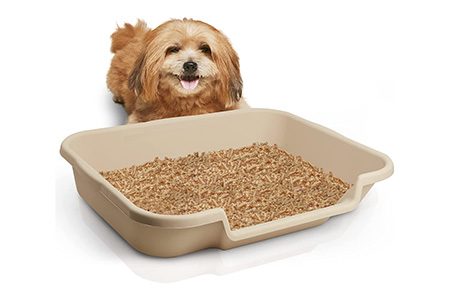
If you thought that litter boxes and trays were only reserved for feline royalty, not anymore! An increasing number of dog parents are opting for litter boxes and trays for their pet dogs.
These are exactly like cat litter boxes, right down to the type of litter (or cat litter alternatives) that’s used, but don’t expect your dog to be as clean, dainty, or as tidy as a cat (not kicking too much litter out of the box and grooming itself after a pooping or peeing session)—you may have to contend with litter trails around the house.
Dogs are generally clumsy animals, so you can expect quite a mess around the litter box too. The fact that they love digging and burrowing and have a penchant for destruction doesn’t help things either.
Considering that the average dog pees three to five times a day (compared to a cat’s two times), that’s quite a bit of daily cleaning up and litter replacement that you’re going to have to do. Additionally, dogs don’t have the natural tendency to cover up their waste like cats, so you may have to contend with an unsavory odor as well, till you clean up.
Also, litter boxes and trays are not ideal for big dogs. Litter boxes are designed for small animals like cats, so while your dog may be comfortable using a litter box in his puppy days, it could get uncomfortable after he grows up, especially if he’s a big dog. Calm, small breeds fare better with litter boxes.
If you’d like to have your dog start using a litter box, start training him or her as soon as possible in the puppy phase. Also, beware that if your dog gets used to the idea of a litter box as a loo, he or she will rarely consider other settings as toilets.
This can be both positive and negative—positive because it means your dog’s not going to treat your furniture and rooms as a toilet and negative because you’ll always have to ensure that there’s a litter box around for your dog, which means carrying it along while camping or traveling, failing which your dog may not relieve itself.
For a small breed, like Pomeranians or Chihuahuas, you can just buy a cat litter box and use it, or if you’re particular, you can consider the rare litter-box styles of dog toilets meant specifically for our canine friends.
Training Pads
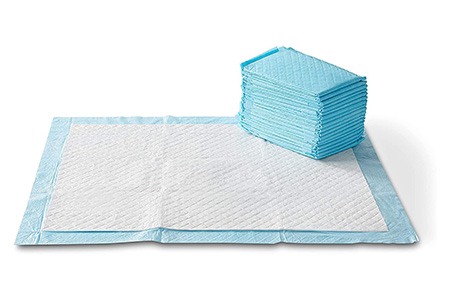
Also known as piddle pads, wee-wee pads, potty pads, pee pads, or simply as dog training pads, these are rectangular or square super-absorbent pads that your dog can safely relieve itself in, without you having to worry about any kind of leakage.
Some pads even come with additional features such as adhesive tabs to keep them stuck to the floor (so that they don’t move or slip when your dog is using the pad) and odor elimination. These are classic dog toilets for young puppies who urinate quite frequently.
You want to quickly train them to associate these pads with a safe place to use the potty, or at least line their cage with them. Though there are types of flooring that are better for pets than others, still, you don't want pee-soaked pads on them. You'll still have cleaning to do and they'll still stink.
Just lay the pad out in a convenient spot for your dog to use, and with a little training, your dog will get used to relieving itself on the training pad. If you’re looking to reduce waste and be more sustainable, consider reusable pads. You can then transition the puppies to better options.
Training Trays
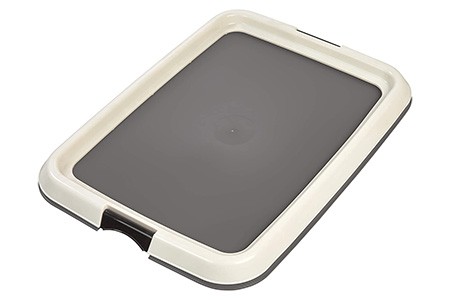
These are the most common toilet solution for dogs, generally used while potty-training puppies. Either training pads or a grate is set into a plastic tray for your dog to pee into. Therefore, they’re quite simple to set up and use—it’s literally just a question of placing the tray somewhere convenient after assembling it, if at all.
There are two types of training trays—one with disposable pads and one with grates or plastic mats. Both of these types of toilets will take some time investment to keep clean, but less so than your dog having an accident on the carpet.
The disposable pads are generally made of cloth, cotton, or other similar materials. These, as the name suggests, can be discarded after use, which means less cleaning up work for you.
However, there’s quite a lot of waste generated when you use disposable pads. Additionally, since you have to continuously keep buying new pads, you’re also going to spend quite a bit on this type of dog toilet.
The training trays without pads feature plastic grates or mats that dogs can relieve themselves on. While these do warrant a little more effort in cleaning up, they’re more sustainable since you can rinse (occasionally with soap) and reuse them. You also won’t have to keep buying replacements, so you’ll be saving quite a bit of money, too.
Trays, since they’re built for house training, are generally ideal for smaller dogs and puppies. Your puppy may take some time to get used to them since they’re an unfamiliar setup, but once they’re familiar with the tray, they’ll be quite comfortable using these.
Indoor Grass Toilets
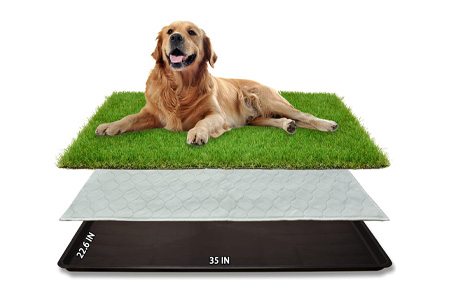
One of the favorite things that dogs love relieving themselves in? Grass! Therefore, a box with grass, either synthetic or real, will have your dog feeling like they’re enjoying a lovely bathroom break in the great outdoors, all within the comfort of home.
Given their natural proclivity for using grass as a toilet, dogs will feel more comfortable using such a pet toilet. I've seen people in big cities who live in condo's in a tall building keep this kind of doggie toilet out on their balcony.
If you opt for a box with real grass, you’re picking the more eco-friendly option. However, you’ll have to regularly replace the grass, usually once a month, which can be a little bit of a financial burden.
You can also opt for containers with synthetic grass, instead, but know that you can’t fool your pooch into thinking that this is real grass! If your dog is a huge fan of natural grass, he or she may not care for the synthetic version too much and even refuse to use it.
However, some brands have high-quality products that come quite close to the real deal, so you could try one of these for your doggo. Some really advanced dog toilets even come with an app for control and sanitizing measures in place to prevent infections in your dog.
While the synthetic ones are not eco-friendly, you won’t be spending too much by way of replacement—you’ll only have to regularly rinse and clean the toilet.
Bear in mind that in its last days, the synthetic grass in these dog toilet types may break or start coming off, and these small bits of plastic are a recycling nightmare.
They’re also a pet parent’s nightmare—given dogs’ penchants for eating anything they can get their jaws on, you may have your dog eating these broken bits and suffering from a range of consequent health issues.
Dog Diapers
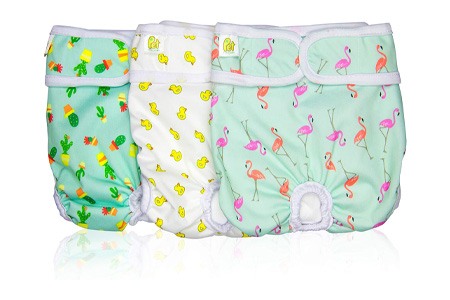
A dog in diapers is not just a cute sight but also one of relief for pet parents! Doggy diapers, just like baby and adult diapers, absorb all urine and feces and are great for elderly dogs or those with health issues and special needs, such as paralysis or incontinence.
Depending on your preferences, you can either opt for reusable diapers (which means that you’ll have to regularly wash these; most of them are machine washable, thankfully) or disposable ones that can just be used and thrown.
Disposable diapers, despite their non-eco-friendly nature, fit the canine body much better than reusable diapers. If your older friend can't make it to the doggy toilet, this is the best solution. Plus, imagine how cute your new pet portraits will look!
Self-Cleaning Toilets
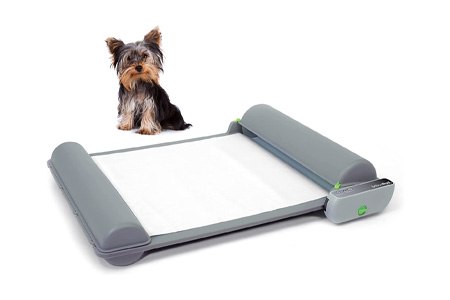
Yes, this dog restroom exists, and yes, they’re a godsend for pupper parents!
A self-cleaning toilet does everything—get rid of soiled pads, replace them with clean pads every time, and even safely store the soiled pads till you can dispose of them. The pads are generally in a roll, allowing the toilet to easily replace pads as and when required (they detect changing time through their sensors).
Usually, the pads are replaced anywhere between once and thrice a day, though you could also set in your preferences in some high-end models. The used pads are stored in a drawer or container in the toilet and you can easily take these out and get rid of them all together instead of changing or cleaning out individual pads.
However, all this luxury comes for a price, and quite a high one, so it might be a wise idea to get your dog used to training pads before investing in a toilet for dogs like this.
Toilets for Dogs So They Can Take Care of Themselves
Dog toilets can be quite handy for dogs who need to frequently relieve themselves, as well as their parents. However, whether or not you actually want to use a dog toilet comes down to a matter of preference—your dog’s ideally, and not yours.
Some dogs just don’t take to toilets other than grass, even after training, and if that’s the case, forcing them won’t do any good. Your dog needs to feel comfortable, and if dog toilets are uncomfortable for your dog, you should be able to provide alternatives to your doggo as a responsible pet parent—even if that means multiple walks a day.



